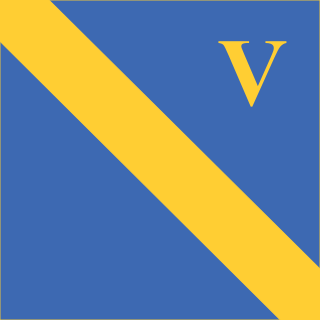
The 5th Infantry Division was a regular army infantry division of the British Army. It was established by Arthur Wellesley, 1st Duke of Wellington for service in the Peninsular War, as part of the Anglo-Portuguese Army, and was active for most of the period since, including the First World War and the Second World War and was disbanded soon after. The division was reformed in 1995 as an administrative division covering Wales and the English regions of West Midlands, East Midlands and East. Its headquarters were in Shrewsbury. It was disbanded on 1 April 2012.
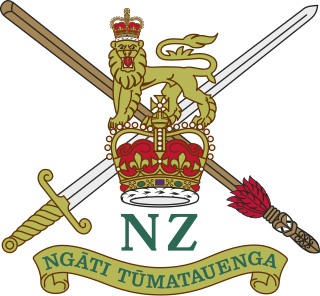
The New Zealand Expeditionary Force (NZEF) was the title of the military forces sent from New Zealand to fight alongside other British Empire and Dominion troops during World War I (1914–1918) and World War II (1939–1945). Ultimately, the NZEF of World War I became known as the First New Zealand Expeditionary Force. The NZEF of World War II was known as the Second New Zealand Expeditionary Force (2NZEF).
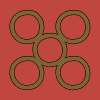
The 32nd Division was an infantry division of the British Army that was raised in 1914, during the First World War. The division was raised from volunteers for Lord Kitchener's New Armies, made up of infantry 'Pals battalions' and artillery brigades raised by public subscription or private patronage. The division was taken over by the War Office in September 1915. It served in France and Belgium in the trenches of the Western Front for the duration of the war. It saw action at the Battle of the Somme, the Pursuit to the Hindenburg Line, the Defence of Nieuport, the German spring offensive, and the Allied Hundred Days Offensive beginning at the Battle of Amiens. After the Armistice it marched into Germany as part of the Army of Occupation.
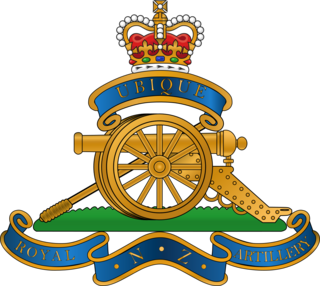
The Royal Regiment of New Zealand Artillery is the artillery regiment of the New Zealand Army. It is effectively a military administrative corps, and can comprise multiple component regiments. This nomenclature stems from its heritage as an offshoot of the British Army's Royal Artillery. In its current form it was founded in 1947 with the amalgamation of the regular and volunteer corps of artillery in New Zealand. In 1958 in recognition of services rendered it was given the title the Royal Regiment of New Zealand Artillery.

The 3rd New Zealand Division was a division of the New Zealand Military Forces. Formed in 1942, it saw action against the Japanese in the Pacific Ocean Areas during the Second World War. The division saw action in the Solomon Islands campaign during 1943–1944, during which it undertook landings on Vella Lavella, the Treasury Islands and the Green Islands. Due to manpower shortages, for most of its existence the division consisted of only two infantry brigades in addition to support personnel, with its third brigade being disbanded shortly after formation. In 1944, manpower shortages in the New Zealand economy became acute led to the disbandment of the division. The majority of its manpower was returned to civilian employment, although around 4,000 men were sent to Italy to reinforce the 2nd Division, seeing further action before the end of the war in May 1945.
N Force was a small New Zealand Army unit of infantry and artillery that garrisoned the Australian territory of Norfolk Island between October 1942 and February 1944, during the Second World War. The island was considered strategically important due to the cable station there that linked Australia and New Zealand. N Force was formed by detaching units from the 3rd New Zealand Division. An airfield was also constructed that was manned by Royal New Zealand Air Force (RNZAF) personnel.
This is the order of battle for the ground forces involved in Operation Crusader, a World War II battle between the British Commonwealth and the European Axis Powers of Germany and Italy in North Africa between 18 November – 30 December 1941.
The 258th Field Artillery Regiment or "Washington Greys" is a field artillery unit of the New York Army National Guard that traces its lineage from 1789 to present. Circa 1957–1966 it consisted of four battalions.
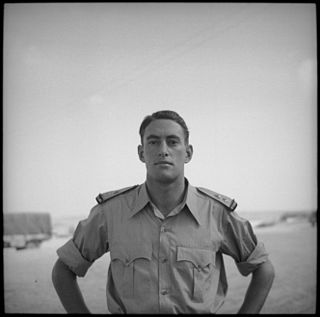
Lieutenant General Sir Leonard Whitmore Thornton, was a senior officer in the New Zealand Army.
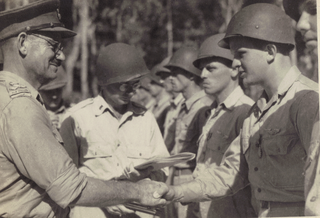
The 8th Brigade was a formation of the New Zealand Military Forces, which served during the Second World War as part of the 2nd New Zealand Expeditionary Force. Eventually forming part of the 3rd Division, the brigade served in the Pacific Ocean theatre of the war. Raised in late 1940, initially the brigade was employed on garrison duties on Fiji before returning to New Zealand in mid-1942. In December 1942, it was sent to New Caledonia where they remained until early September 1943, when they moved to Guadalcanal to prepare for operations in the Solomon Islands. The brigade's only combat operation of the war came in October–November 1943, when it captured the Treasury Islands. It was disbanded in late 1944 due to manpower shortages in the New Zealand economy.

The 1st Brigade is currently the largest unit of the New Zealand Army, and contains most of the army's deployable units. The brigade was formed on 13 December 2011 by amalgamating the 2nd Land Force Group and 3rd Land Force Group. Its establishment formed part of the 'Army 2015' package of reforms.
The 35th Battalion was an infantry battalion of the New Zealand Military Forces, which served in the Pacific theatre of the Second World War from 1941 to 1944. Attached to the 14th Brigade, the battalion was formed in late 1941 and saw service in the Pacific against the Japanese as part of the New Zealand 3rd Division. It initially performed garrison duties on Fiji and New Caledonia before being committed to the fighting in the Solomon Islands in 1943. Returned to New Zealand in late 1944, the battalion was disbanded in early 1945 during a partial demobilisation of New Zealand forces. Many of its personnel returned to civilian employment while others were sent to Italy as reinforcements for the New Zealand 2nd Division. The battalion was awarded four battle honours for its various engagements during the war.
Major General Walter Sneddon McKinnon, was an officer in the New Zealand Army. He joined the military in 1935 and served in the Second World War with various artillery units of the Second New Zealand Expeditionary Force. After the war he held a series of senior positions in the army, culminating with a term as Chief of the General Staff from 1965 to 1967. In his retirement, he was Chairman of the New Zealand Broadcasting Corporation.

The 2/2nd Field Regiment was an Australian Army field artillery regiment that was raised for service during the Second World War. Assigned to the 6th Division, the regiment was formed from Second Australian Imperial Force volunteers. Raised in October 1939, the regiment undertook basic training in Australia before departing for the Middle East in mid-1940. Further training was undertaken in Egypt, before the regiment saw action in the Western Desert in early 1941, and in Greece and on Crete in the middle of the year. Later, they provided a defensive garrison on Ceylon in mid-1942 before returning to Australia. It did not see further action until the final phase of the war, when it was deployed to Aitape–Wewak, fighting against the Japanese, in 1944–1945. It was disbanded in January 1946, after returning to Australia for demobilisation.

The 1st Mountain Battery was an Australian Army artillery battery formed in July 1942, that served during the Second World War, seeing action against the Japanese during the Battle of Buna–Gona and the Salamaua–Lae campaign in 1942–43. The unit was added to the 1st Parachute Battalion in August 1944 providing an organic indirect fire support, equipped with Short 25-pounder guns, but did not see further action in this role. The battery was disbanded in 1946.
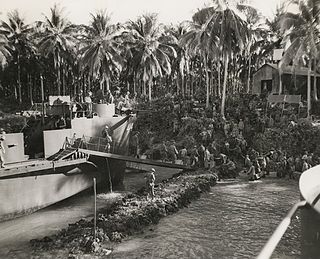
The 14th Brigade was a formation of the New Zealand Military Forces, which served during the Second World War as part of the 2nd New Zealand Expeditionary Force. Eventually forming part of the 3rd Division, the brigade served in the Pacific Ocean theatre of the war. Raised in December 1941, the brigade undertook garrison duties in Fiji before being relieved by US troops in mid-1942. After this, it took part in two combat actions against Japanese forces in 1943–1944: the Land Battle of Vella Lavella and the Battle of the Green Islands. In mid-1944, the brigade was broken up to return manpower to New Zealand industry and to meet the reinforcement needs of the 2nd Division in Italy.
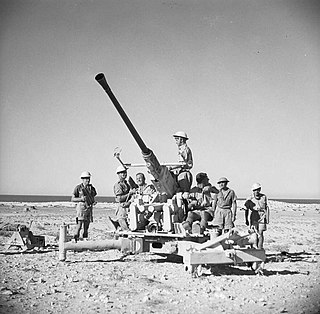
The 14th Light Anti-Aircraft Regiment was an air defence regiment of the New Zealand Military Forces raised during the Second World War. It saw service as part of the 2nd New Zealand Division during the North African, Tunisian and Italian campaigns, before being disbanded in October 1944.

The 29th Light Anti-Aircraft Regiment was an air defence regiment of the New Zealand Military Forces raised during the Second World War. It saw service as part of the 3rd New Zealand Division during the Solomon Islands campaign and was disbanded in October 1944.

Brigadier Raymond Candlish Queree, was a senior officer in the New Zealand Military Forces during the Second World War and the postwar period.

The 38th Field Regiment was an artillery regiment of the New Zealand Military Forces raised during the Second World War. The regiment was formed on 12 April 1943 at Papakura Military Camp and consisted of 49, 50 and 52 Batteries. The regiment departed New Zealand in eight different ships between May and July and continued training in New Caledonia. From late October till November 1943 it took part in the Battle of the Treasury Islands as part of the 8th Brigade Group. From April 1944, 38th Field Regiment began to have men transferred to other units or returned home to work in essential industries due to a manpower shortage. The regiment had been reduced to 48 men by August and the entire 3rd Division was formally disbanded in October 1944.















